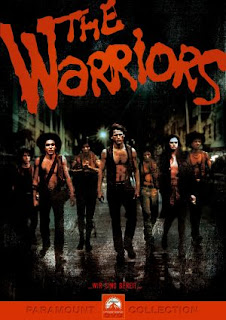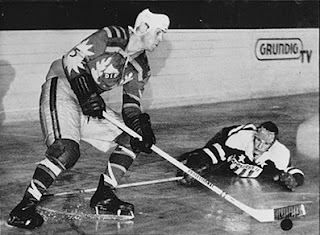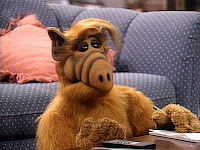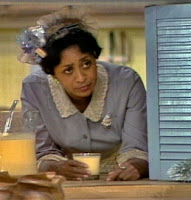Probably the most celebrated artist of Batman's earliest days is Dick Sprang - whose square-jawed, barrel-chested Batman, while not very anatomically accurate, was very visually striking and helped lay the groundwork for all depictions that followed. (Although it should be noted there were others before him.) Nowadays the style can be criticized as being overly cartoony and simplistic but what it comes down to is that it is still unmistakenly Batman.
In the mid-sixties Carmine Infantino introduced a Batman that was more realistic-looking and better fit the stories that were being told, as Batman moved away from the goofier stuff he'd been involved in in the fifties. It's not a look that I particularly enjoy myself though. It just wasn't dynamic enough for my tastes. And the way he drew the mouth actually kinda bugs me - too much emphasis on the lips or something. But that's just nit-picking, really.
It really hurt to not be able to include the late Gene Colan for the work he did in the first half of the eighties. In the seventies he'd been the artist for Marvel's Tomb Of Dracula series and he really brought that shadowy, horror style to Batman and Gotham which worked extremely well. He really keyed on the idea that when Batman suits up and goes out he becomes a sort of creature of the night.
I could go on of course but let's get to the list, where some of those who didn't get entries are at least mentioned.
 5. Tony Daniel
5. Tony Daniel I really wanted to put Andy Kubert, son of the legendary Joe Kubert and brother of Adam, in this spot but ultimately decided he hasn't done quite enough Batman so far to warrant it. So I went with the artist whose Batman looks the most like Kubert's to me - Tony Daniel. He's also the artist who took over for Kubert working with writer Grant Morrison. He drew Batman: R.I.P. as well as the followup Batman: Battle for the Cowl. When The New 52 started, he was the artist as well as writer for the first twelve issues of Detective Comics, plus one annual and an issue #0.
Drawing with a very noir-influenced style, Daniel has to be the most definitive Batman artist of the last few years at least. I especially love how he does the cape - in some shots it looks almost endless as it flows out behind our dark hero. It reminds me a bit of Tim Sale's version of the character, which is a good thing.
I also really like that Daniel has a real feel for Batman's physique and how it differs from other characters like Nightwing (especially important given he's drawn Dick Grayson as Batman - please note that the picture here is of the Bruce Wayne version). Batman's official height and weight is 6'2, 210 - he's a big, broad-shouldered guy and obviously quite physically powerful, but he's still lean enough to be very quick. I feel Daniel's Batman conveys this in every frame.
4. Marshall Rogers
 OK, so I just omitted Kubert because I said he doesn't have a big enough Batman body of work to draw from and now I'm picking Rogers - a guy who actually didn't do that much himself. But it's just so memorable and influential that I can't overlook it. While he would do a couple miniseries and one-shots in the years afterward, it's his short run on Detective Comics with writer Steve Englehart in 1977 and 78 that earned him a place in Batman history as one of its greatest artists. Included in that run was the famous story The Laughing Fish. Marshall's look for the character directly influenced both the 1989 film Batman and Batman: The Animated Series.
OK, so I just omitted Kubert because I said he doesn't have a big enough Batman body of work to draw from and now I'm picking Rogers - a guy who actually didn't do that much himself. But it's just so memorable and influential that I can't overlook it. While he would do a couple miniseries and one-shots in the years afterward, it's his short run on Detective Comics with writer Steve Englehart in 1977 and 78 that earned him a place in Batman history as one of its greatest artists. Included in that run was the famous story The Laughing Fish. Marshall's look for the character directly influenced both the 1989 film Batman and Batman: The Animated Series.Style-wise, Rogers was somewhat close to Neal Adams insofar as he was definitely a part of the movement by artists of the later sixties and throughout the seventies to depict a more realistic-looking Dark Knight. I would say that what probably sets him apart the most was just how intense his Batman always looked. Usually he would have a grimace or scowl on his face as he dispensed justice. Batman no longer looked cartoony by this point and Rogers could make him look downright scary.
Although he's a renowned artist for more than just his contribution to Batman and has worked on many different titles throughout his lengthy career, I think it's safe to say that it will always be considered his greatest artistic achievement.
3. Jim Lee
 Apparently I'm throwing all my rules out the window because once again we have an artist who hasn't actually done a ton of Batman, although now that he's drawing the newest incarnation of Justice League (The New 52), we'll get to see a lot more of it.
Apparently I'm throwing all my rules out the window because once again we have an artist who hasn't actually done a ton of Batman, although now that he's drawing the newest incarnation of Justice League (The New 52), we'll get to see a lot more of it.I'm almost at a loss for what to say about Lee's Batman - everything the man draws just looks awesome. Probably well before he actually drew the character in any official capacity anyone who was familiar with his existing work knew that he would do a great job with it (for the record, I also believe he is one of the best artists to draw Superman as well). It's no surprise that his first work - the twelve-part storyline Hush, written by Jeph Loeb - sold very well and was also critically adored (for the most part). He would later team with Frank Miller for the much-maligned, often delayed All Star Batman and Robin and while I find Miller's writing laughable in some parts, the art is of course beautiful. It's very difficult to find Batman looking better than he does there. In fact, his art is so admired that DC would go on to release a special version of Hush called Batman: Hush Unwrapped which features Lee's original pencil work before the inking and colouring was added
I think the main aspect Lee's Batman conveys is power. He looks like a Greek statue come to life wearing a mask and cape; just incredibly physically imposing without being over the top and unrealistic. Earlier I criticized Infantino's Batman for not being dynamic-looking; well, Lee's is the absolute epitome of dynamic. His art in general just has that look sometimes described as "leaping off the page" and with Batman that's definitely the case.
 2. Norm Breyfogle
2. Norm Breyfogle By this point you must be asking if the most celebrated Batman artist of the eighties - Jim Aparo (who actually started in the seventies) - is getting a spot here. While I do think he's very important to Batman's legacy and did a great job, the answer is no and it's really just a case of personal preference.
For my Number Two slot I'm going with a guy you probably haven't even heard of and it's my belief (and some others somewhere must share it) that Norm Breyfogle is criminally underrated and underappreciated (I've decided that's a real word, yes) for his contribution to Batman. It's highly possible that it's because he's one of the first Batman artists I was exposed to when I first began seriously reading comics that he ranks so high. But even nostalgic feelings aside, I just love what he brings to the character and his habitat, Gotham City.
In one respect, Breyfogle's Batman is every bit as unrealistic-looking as Sprang's. But in a much different way. Throughout the late eighties and early nineties, he gave us a totally trippy, twisted-looking Batman. As this was the Dark Age of Comics, it shouldn't be too surprising that a Batman artist was doing characters with exaggerated proportions but if you really look at it, his style really wasn't comparable to someone's like Rob Liefeld. Breyfogle's trademark was faces with insane, distorted expressions which came across as dramatic rather than silly. In some ways his style was a lot like Colan's but more sharp and angular. And no artist so far has drawn a Gotham as close to what I imagine as he has - flashy and grand in some areas while grimy and claustrophobic in others. And somehow terrifying in all of them.
Breyfogle proved that the realistic style that had become the trend could be broken away from without sacrificing drama and seriousness. In many ways his style could even enhance those elements. His pairing with writer Steven Grant might be my favourite creative team in all of Batman and can be seen at its best in the early issues of Shadow of The Bat. He was also the first artist to draw the Tim Drake version of Robin (finally a costume that wasn't totally embarrassing!) and co-created villains The Ventriloquist and Mr. Zsasz.

1. Neal Adams
I of course wasn't around when Neal Adams first drew Batman so I can only speculate on what my response to it back then would have been. I think that if I had been reading Batman comics steadily before Adams's entry, I would have been deliriously pleased upon first viewing his work. I believe I would have felt as though I was really seeing the character for the very first time outside of what I'd always imagined. That I was finally viewing Batman's archetype, that is, his form as described by Plato.
Am I going overboard in my praise here? I suppose it's possible but I just can't help it. To me, Adams's Batman is almost perfect. His covers have to be the best there are. They evoke such a cinematic feel that later artists such as Lee, Aparo, David Finch and even Frank Miller would strive to imitate it in their own ways. Following up on Infantino's Batman, here was one with much more defined lines and sharper edges. His movements were much more fluid on the page. In fact sometimes when I find myself looking at a particularly large panel featuring Adams's Batman I can almost see it move.
Adams was part of a generation of comic book artists who helped emphatically declare that their work on the medium was far from throwaway fare and was a legitimate form of art. Jim Sterenko's work over at Marvel is another example. Both would use photographs as guides for some of their drawing, paying keen attention to both anatomy and architecture. And like Colan, Adams had a background in horror-themed comics and brought some of those elements to Batman.
Adams drew Batman in such a realistic yet still otherwordly style that it perfectly encapsulated what comic book superheroes are supposed to be - characters of fantasy who perform incredible deeds but who we could still somehow imagine as being part of our "real" world as well. It's exactly because of an artist like Adams that I can never really accept seeing any actor play Batman in a movie - no real person or real costume could ever live up to the ideal he created.








































